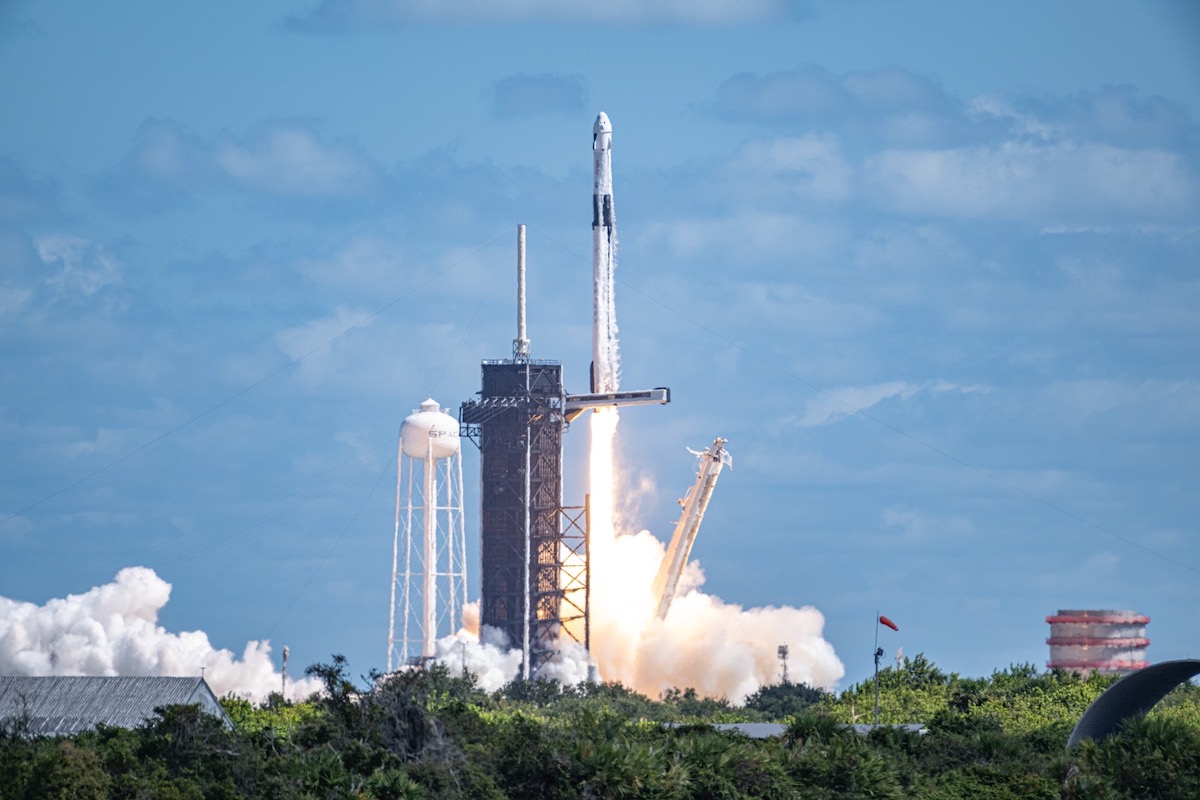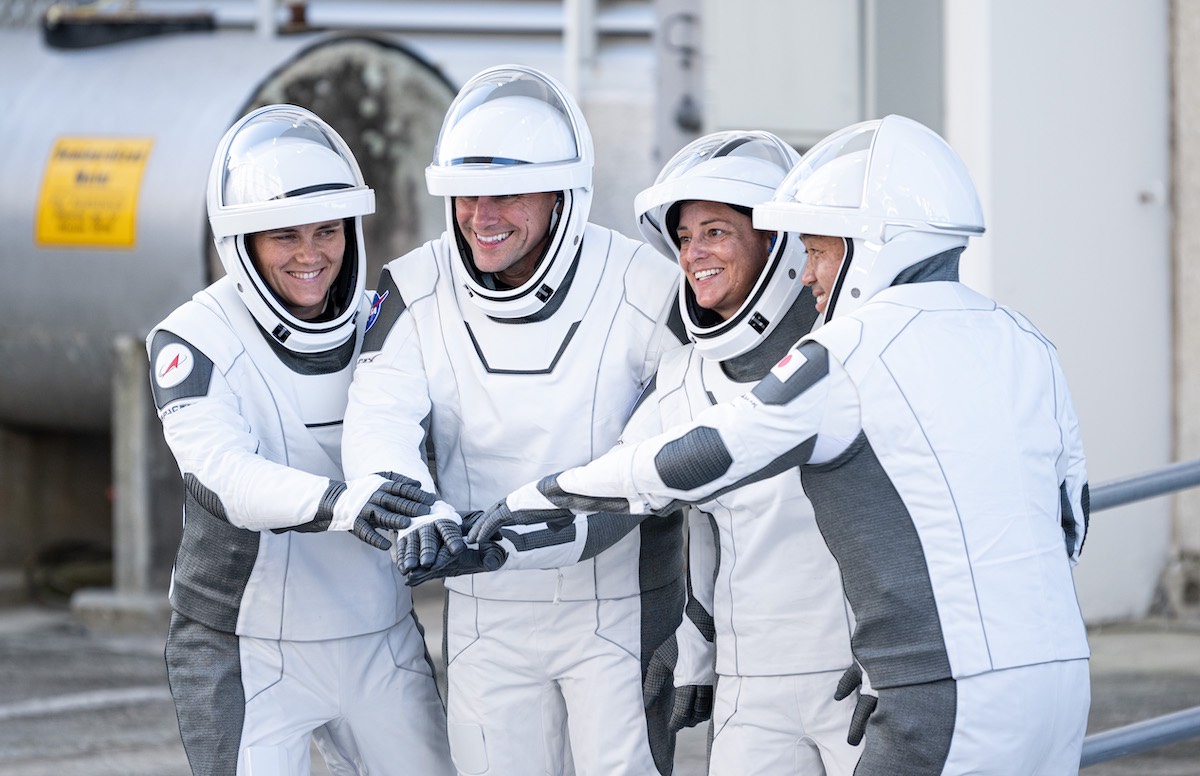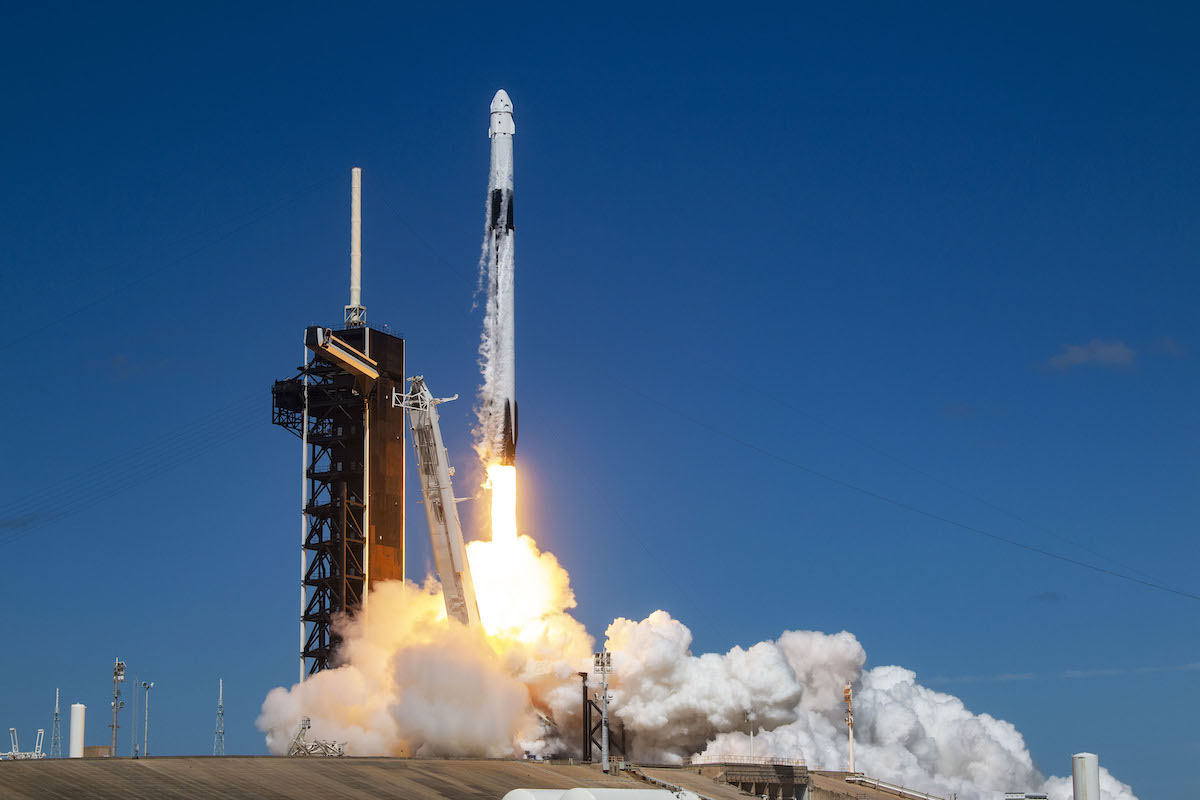Space News & Blog Articles
U.S.-Russian-Japanese crew lifts off from Florida heading for space station
 SpaceX’s Falcon 9 rocket and Dragon Endurance spacecraft, carrying a crew of four, depart NASA’s Kennedy Space Center on Wednesday heading for the International Space Station. Credit: Michael Cain / Spaceflight Now / Coldlife Photography
SpaceX’s Falcon 9 rocket and Dragon Endurance spacecraft, carrying a crew of four, depart NASA’s Kennedy Space Center on Wednesday heading for the International Space Station. Credit: Michael Cain / Spaceflight Now / Coldlife Photography
Two NASA astronauts, a veteran Japanese space flier, and the first Russian cosmonaut to launch on a U.S. spacecraft since 2002 soared into orbit Wednesday from Kennedy Space Center in Florida aboard a SpaceX Falcon 9 rocket, in what could signal an easing of tension between NASA and the new leadership of the Russian space agency.
The four-person crew took off from pad 39A at Kennedy at 12:00:57 p.m. EDT (1600:57 GMT) Wednesday, two days later than previously scheduled due to delays caused by Hurricane Ian, which struck Florida last week.
Nine Merlin 1D engines on the bottom of SpaceX’s Falcon 9 rocket ignited with a flash of orange, sending a plume of exhaust out of the launch pad’s flame trench as hold-down clamps released to allow the 215-foot-tall (65-meter) launcher to climb away from the space center.
The Falcon 9 vectored 1.7 million pounds of ground-shaking thrust from its nine engines to steer northeast away from the Florida spaceport, aligning with the flight path of the International Space Station. The rocket surpassed the speed of sound in less than a minute, then shut down its first stage engines about two-and-a-half minutes into the mission. After releasing the booster stage, the Falcon 9’s second stage ignited a single engine to finish the job of placing SpaceX’s Dragon Endurance crew capsule into orbit.
NASA commander Nicole Mann, a U.S. Marine Corps colonel and former F/A-18 test pilot, acknowledged periodic status reports from SpaceX mission control in California. The Falcon 9’s upper stage cut off its engine nearly nine minutes after liftoff after reaching an on-target orbit. A few minutes later, the Dragon spacecraft deployed from the rocket to begin its automated pursuit of the space station.
“Thank you so much to the Falcon team,” Mann radioed from the Dragon spacecraft. “Woo! That was a smooth ride uphill. We’ve got three rookies that are pretty happy to be floating in space right now, and one veteran astronaut who’s pretty happy to be back as well.”
Mann is the first Native American woman to fly in space and the first woman to command a mission on a Dragon spacecraft.
Liftoff of SpaceX’s Falcon 9 rocket and Dragon Endurance spacecraft, carrying Nicole Mann, Josh Cassada, Koichi Wakata, and Anna Kikina into orbit to begin a five-month science expedition on the International Space Station. https://t.co/x0vLBWltfw pic.twitter.com/HVJjXouCv7
— Spaceflight Now (@SpaceflightNow) October 5, 2022
Josh Cassada, a Navy captain and pilot with a doctorate in high energy physics, was in the pilot’s seat inside the Dragon Endurance spacecraft for launch. Russian cosmonaut Anna Kikina was in the right seat of the Dragon spacecraft for launch. Mann, Cassada, and Kikina launched on their first flight to space.
Veteran Japanese astronaut Koichi Wakata rode to orbit in the left-hand seat of the Dragon capsule to kick off the fifth spaceflight in his career, following prior missions on NASA’s space shuttle and Russian Soyuz spacecraft. The Falcon 9 and Dragon are third type of vehicle Wakata has flown into space.
The Dragon Endurance spacecraft activated its maneuvering thrusters and opened its nose cone soon after launching into orbit Wednesday. A series of orbit adjustment burns are planned to reach the space station, and the capsule is scheduled to dock with the complex on autopilot at 4:57 p.m. EDT (2057 GMT) Thursday after a 29-hour transit.
This flight, known as Crew-5, marks the fifth operational crew rotation mission to the station using a SpaceX crew capsule. It was SpaceX’s eighth launch of astronauts overall, including a demonstration mission in 2020 for NASA, and two all-private crew flights to low Earth orbit.
Mann, Cassada, Wakata, and Kikina are beginning a five-month science expedition at the station. They are scheduled to return to Earth in late February.
Kikina was confirmed as the fourth crew member for Crew-5 mission in July, when NASA and the Russian space agency, Roscosmos, finalized a “seat swap” agreement enabling Russian cosmonauts to launch and land on U.S. crew capsules and U.S. astronauts to fly to the space station on Russian Soyuz missions.
 The Crew-5 astronauts during walkout from crew quarters at NASA’s Kennedy Space Center on Wednesday. From left to right: Russian cosmonaut Anna Kikina, Crew-5 pilot Josh Cassada, Crew-5 commander Nicole Mann, and Japanese astronaut Koichi Wakata. Credit: Michael Cain / Spaceflight Now / Coldlife Photography
The Crew-5 astronauts during walkout from crew quarters at NASA’s Kennedy Space Center on Wednesday. From left to right: Russian cosmonaut Anna Kikina, Crew-5 pilot Josh Cassada, Crew-5 commander Nicole Mann, and Japanese astronaut Koichi Wakata. Credit: Michael Cain / Spaceflight Now / Coldlife Photography
The seat sharing agreement is intended to ensure the space station is always staffed by at least one U.S. and one Russian crew member, allowing each country’s segment of the complex to remain fully operational even if there was a major problem or delay in U.S. or Russian crew launches.
The U.S. segment of the outpost provides most of the lab’s electrical power, while Russia’s modules provide propulsion to maintain the station’s orbit. Each partner’s reliance on the other makes it difficult for NASA or Roscosmos, Russia’s space agency, to unilaterally withdraw from the project without jeopardizing all space station operations.
The new seat swap agreement is also designed to protect against the risk of a medical emergency forcing the evacuation of an entire Russian Soyuz or U.S. spacecraft crew. If that happened, at least one U.S. or Russian crew member would still remain on the station.
NASA astronaut Frank Rubio launched to the space station Sept. 21 on a Soyuz spacecraft, alongside Russian cosmonauts Sergey Prokopyev and Dmitry Petelin.
“With the flight of Soyuz and flight of Crew-5, we will start what we call integrated crews, or exchange flights, when one crew member from the Russian segment will fly on an American vehicle and one American will fly on a Russian vehicle,” said Sergei Krikalev, a veteran cosmonaut and executive director of human spaceflight programs at Roscosmos.
“This type of exchange will increase the robustness of our program, and we will continue this practice to make our program more reliable,” Krikalev said.
 SpaceX’s 215-foot-tall (65-meter) Falcon 9 rocket and Dragon Endurance spacecraft lift off from pad 39A. Credit: SpaceX
SpaceX’s 215-foot-tall (65-meter) Falcon 9 rocket and Dragon Endurance spacecraft lift off from pad 39A. Credit: SpaceX
The new head of Roscosmos, Yuri Borisov, said in July that Russia would withdraw from the International Space Station program after 2024, spawning headlines that NASA’s main partner on the project could leave in as soon as two years.
But Russian officials quickly clarified the statement, saying Roscosmos would only leave the International Space Station after it builds an independent complex in low Earth orbit, something not expected before 2028, in a best case scenario for Russia’s space program.
Krikalev, who flew on two NASA space shuttle missions in the 1990s, is a longtime manager in Russia’s human spaceflight program. His former boss at Roscosmos, Dmitry Rogozin, was unexpectedly removed from his position at the Russian space agency in July by President Vladimir Putin.
Rogozin was known for bellicose statements against NASA and Western nations throughout his tenure at Roscosmos, and his threats grew more aggressive in the wake of sanctions against Russia following the country’s invasion of Ukraine earlier this year.
Asked Wednesday if he and Borisov, the new leader of Roscosmos, are attempting ease tensions with the U.S. space agency, Krikalev replied: “I would say yes.”
The space station’s lifetime has already been extended from earlier retirement dates in 2015 and 2020. U.S.-Russian cooperation in space goes back to the Apollo-Soyuz mission in 1975, and construction of the International Space station began in 1998.
“We started to cooperate many years ago, more than 40 years ago, and we will continue our cooperation as long as I can imagine,” Krikalev said Wednesday after the Crew-5 launch.
 SpaceX’s Falcon 9 rocket and Dragon Endurance spacecraft climb away from NASA’s Kennedy Space Center on Wednesday. Credit: Michael Cain / Spaceflight Now / Coldlife Photography
SpaceX’s Falcon 9 rocket and Dragon Endurance spacecraft climb away from NASA’s Kennedy Space Center on Wednesday. Credit: Michael Cain / Spaceflight Now / Coldlife Photography
The Biden administration announced earlier this year it supports extending NASA’s participation in the International Space Station program through 2030. NASA’s other partners on the ISS — Canada, Japan, and the European Space Agency — are expected to follow the U.S. lead, though those nations and agencies are still going through a formal extension process.
“When we started this program, every module was built in order to fly for 15 years. We actually exceeded this 15 year time mark a long time ago, and the station was extended a couple of times,” Krikalev said. “Right now, we have agreement to fly together up to 2024. We already talked with our international partners, and are talking with our specialists on it in Russia, looking through the technical capability of station to (continue to) fly. And we understand that it makes sense to keep flying because this excellent infrastructure that we built space can be used for for humanity, even more than we initially planned.”
NASA and its partners have spent more than $100 billion building and maintaining the space station since the 1990s.
“I think from the very beginning we understood that station is very valuable to do science on its base on low Earth orbit, but also we understand that station is good (to prepare) for more exciting mission to fly beyond low Earth orbit,” Krikalev said. “And we can test a lot of equipment, a lot of procedures, a lot of methods of flying, working on the International Space Station. So that’s what we’re keeping now. We are going to keep it in the future, and we will see how long station will be able to fly, and I think the main limitation will be technical reasons.”
Krikalev said earlier this week Roscosmos hopes to have “permission” from the Russian government next year to continue working on the space station program after 2024.
“Wooo! That was a smooth ride uphill!” says commander Nicole Mann on SpaceX’s Dragon Endurance spacecraft.
The Dragon capsule has separated from the Falcon 9 after arriving in orbit, heading for docking at the space station tomorrow.https://t.co/x0vLBWkVpY pic.twitter.com/ZzipJ1zdjz
— Spaceflight Now (@SpaceflightNow) October 5, 2022
The space station was largely completed in 2011 with the last flights of NASA’s space shuttle. The retirement of the shuttle left Russia’s Soyuz spacecraft as the only way for crews to travel to and from the station until SpaceX’s Crew Dragon came online in 2020 after a decade-long development in partnership with NASA.
Boeing has a similar NASA commercial crew contract as SpaceX, but its Starliner crew capsule has run into delays. The first Starliner flight with astronauts is currently scheduled for February. Once the Boeing spacecraft is operational, there will be three independent vehicles capable of ferrying astronauts and cosmonauts between Earth and the International Space Station.
The arrival of the Crew-5 mission at the station will temporarily raise the size of the lab’s crew to 10 until the outgoing Crew-4 mission departs and returns to Earth in mid-October on SpaceX’s Dragon Freedom spacecraft.
The Crew-4 mission, which is been in orbit since April, is commanded by NASA astronaut Kjell Lindgren, on his second flight to space. NASA’s Crew-4 pilot Bob Hines, European Space Agency astronaut Samantha Cristoforetti, and NASA mission specialist Jessica Watkins will also come back to Earth on the Dragon Freedom spacecraft, targeting a splashdown off the cost of Florida.
This email address is being protected from spambots. You need JavaScript enabled to view it. the author.
Follow Stephen Clark on Twitter: @StephenClark1.
When you subscribe to the SpaceZE News Feed, we will send you an e-mail when there are new updates on the site so you wouldn't miss them.

